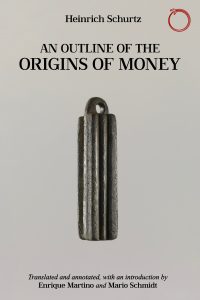By Heinrich Schurtz
Translated and annotated, with an introduction by Enrique Martino and Mario Schmidt
Foreword by Michael Hudson
“On this subject, I only knew the excellent little book by the late Schurtz”
— Marcel Mauss, 1914, “Les origines de la notion de monnaie”.
Heinrich Schurtz’s 1898 book has been a touchstone for economic historians, anthropologists, and philosophers interested in the nature and origins of money in various societies, including Georg Simmel, Max Weber, Marcel Mauss, and Karl Polanyi. Schurtz experimented with concepts about money, going beyond traditional economic paradigms. Drawing on an extensive range of archaeological and ethnographic sources, he reframed a theory of money to include its materiality, symbolic nature, relationship to forms of property, and its dual origin in “outside-” and “inside-money.” While not well known today, it was important to the theorization of money in the first half of the 20th century and its innovative synthesis offers galvanizing questions and insights into how value relations are formed and how currency systems are interrelated.
“Money is not just, or even primarily, a means of facilitating exchange. Schurtz finds its origin – and paradigm – in the aesthetic radiance that certain ornaments exert on human minds, arousing ‘the envy of fellows and the admiration of women’; what he calls ‘inside-money’. By meeting the needs of commerce, this primary social power is transmuted into purchasing power, giving rise to the money we know. We must thank Enrique Martino and Mario Schmidt for placing these valuable reflections in our hands.”
— André Orléan, author of The Empire of Value: A New Foundation for Economics, “The Origin of Money” and “Value and Money as Social Power”.
“Schurtz’s An Outline of the Origins of Money brings to light the brilliance of an intellectual journey cut short. This work positions Schurtz as a minor classic, comparable to Marcel Mauss, and more than a historical curiosity for specialists only. Unrecognized yet subliminally influential, Schurtz straddles the line between the greats like Weber and Simmel and the era-specific figures such as Bücher and Sombart.”
— Jürgen Osterhammel, author of The Transformation of the World: A Global History of the Nineteenth Century, and co-editor of Max Weber and His Contemporaries.
“Around the world in eighty currencies. Schurtz’s book is a pioneering contribution to define the concept of money in the horizon of global culture. A passionate ethnographic campaign to discover the economic customs of humankind, in its historical evolution, among the most diverse cultures, in the extraordinary polymorphism of the media of currencies.”
— Carlotta Santini, author of “Friedrich Nietzsche in Basel: An Apology for Classical Studies” and “Can Humanity be Mapped? Adolf Bastian, Friedrich Ratzel and the Cartography of Culture”.
“What are the origins of money? According to Heinrich Schurtz, only Indigenous peoples have an answer to this question. Thereby, he brings his readers through a journey into the material forms and social uses of money across the globe. With this translation, a hidden gem will become a classic for scholars interested in how money is made, accepted, and transformed by people daily using it.”
— Karin Pallaver, editor of Monetary Transitions: Currencies, Colonialism and African Societies and co-author, together with Jane Guyer, of “Money and Currency in African History”.
Heinrich Schurtz (1863–1903) was a German ethnologist who was trained and taught at the University of Leipzig. He is the author of Altersklassen und Männerbünde, Urgeschichte der Kultur, and Das Afrikanische Gewerbe.
Michael Hudson is a Distinguished Research Professor of Economics at University of Missouri–Kansas City. Among his many books on international finance, economic history, and the history of economic thought are Super Imperialism: The Economic Strategy of American Empire and Trade, Development and Foreign Debt. In conjunction with Harvard University’s Peabody Museum, he headed a research team on the origins of private property, debt, and real estate, which resulted in edited publications such as Debt and Economic Renewal in the Ancient Near East, and monographs including …and forgive Them their Debts: Lending, Foreclosure and Redemption From Bronze Age Finance to the Jubilee Year and Temples of Enterprise: Creating Economic Order in the Bronze Age Near East.
Enrique Martino has a PhD from the Humboldt University of Berlin and is a Juan de la Cierva Postdoctoral Fellow at the department of Historia, Teorías y Geografía Políticas of the Complutense University of Madrid. He is the author of Touts: Recruiting Indentured Labor in the Gulf of Guinea, and “Irrationality and Speculation in Finance”.
Mario Schmidt is an associate researcher at the Max Planck Institute for Social Anthropology (Halle/Saale) and a senior research specialist at Busara in Nairobi. He is the author of Wampum und Biber: Fetischgeld im kolonialen Nordamerika, and co-edited the volumes Marcel Mauss: Schriften zum Geld, and Money Counts: Revisiting Economic Calculation.
© HAU Books 2024
© 2024 Michael Hudson, Foreword: “The Institutional-Systemic Origins of Money”
ISBN: 9781914363078 [paperback]
ISBN: 9781914363276 [PDF]
ISBN: 9781914363283 [e-book]
6″ x 9″, 274 pp.
21 halftones
$23
Buy this book from The University of Chicago Press
Download PDF (Coming Soon)
The open-access PDF of this book, attached above, is made available by Hau Books through a Creative Commons license BY-NC-ND 4.0 International (Attribution Required / Non-Commercial Use / No Derivatives). Additional rights clearance may be necessary for third-party content within.
